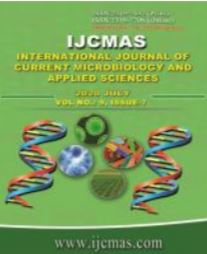


 National Academy of Agricultural Sciences (NAAS)
National Academy of Agricultural Sciences (NAAS)

|
PRINT ISSN : 2319-7692
Online ISSN : 2319-7706 Issues : 12 per year Publisher : Excellent Publishers Email : editorijcmas@gmail.com / submit@ijcmas.com Editor-in-chief: Dr.M.Prakash Index Copernicus ICV 2018: 95.39 NAAS RATING 2020: 5.38 |
Field experiments were conducted in the wetland farms of Department of Agronomy, Tamil Nadu Agricultural University, Coimbatore during Rabi and Summer 2019-2020. Both the experimental trials consists of nine treatments of randomized block design which were replicated thrice. The treatments comprise of sulfentrazone with and without encapsulation @ 0.30 kg ha-1 applied at 1 DBS and 2 DAS followed by general recommended herbicides and weed management methods for blackgram. Sulfentrazone herbicide was encapsulated by using solvent evaporation method for season long weed management and to reduce the leachability. These treatments were tested to know their effect on soil bacterial, fungal and actinomycetes population and also the nodulation ability of blackgram crop. All the herbicide applied treatments were showed reduction in bacterial, fungal and actinomycetes population at 25 DAS compared to initial population, but slight increase in the population of T7 (Two hand weedings at 15 and 30 DAS), T8 (Weed free check)and T9 (Absolute control)treatments in both the trials. At 50 DAS there was great increase in microbial population compared to 25 DAS in all herbicide applied treatments. There was no significant difference among all the treatments at 50 DAS in microbial population. Higher nodule count and nodule dryweight were noticed at 30 DAS in T9 (Absolute control), T8 (Weed free check) and T7 (Two hand weedings at 15 and 30 DAS) which is followed by T1 (Encapsulated sulfentrazone @ 0.30 kg a.i. ha-1applied at 1 DBSand T6 (Pendimethalin @ 1kg a.i. ha-1applied at 2 DAS fb hand weeding at 20 DAS). But at 60 DAS there was no significant difference among the treatments except with unweeded control.
 |
 |
 |
 |
 |